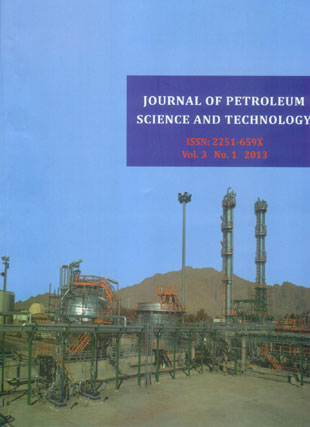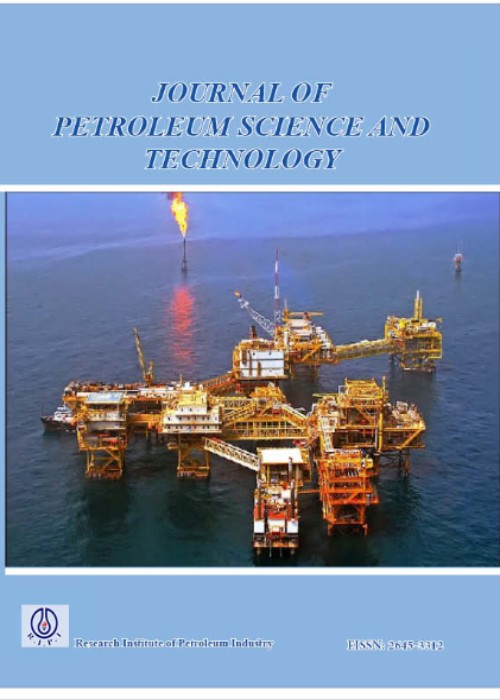فهرست مطالب

Journal of Petroleum Science and Technology
Volume:3 Issue: 1, Spring 2013
- 74 صفحه،
- تاریخ انتشار: 1392/03/01
- تعداد عناوین: 8
-
-
Pages 1-7In this study, the effects of particle size distribution improvement and dense packing techniques on the 28- and 90-day compressive strengths of class G oil well cement have been investigated. It was observed that limited improvements in the particle size distribution of cement (regarding industrial possibilities) cannot result in a significant increase in 28- and 90-day compressive strengths. Also, in the application of the dense packing technique, silica fume and limestone powders with the grain size less than 45 micrometers cannot be utilized as substitutes for cement, because the addition of these materials simultaneously leads to the shortening of the setting times. The utilization of quartz powder as a filler exhibits partial pozzolanic properties at optimum substitution percentages, i.e. around 6 to 10% by weight; however, it can result in an almost 7% increase in the 28-day compressive strength of the hardened paste of the cement without any considerable effects on its setting times.Keywords: Class G, Oil Well Cement, Particle Size Distribution, Dense Packing, Compressive Strength
-
Pages 9-19In the present work, the effects of operating conditions including pH, transmembrane pressure, oil concentration, and temperature on fouling resistance and the rejection of turbidity for a polymeric membrane in an ultrafiltration system of wastewater treatment were studied. A new modeling technique called evolutionary polynomial regression (EPR) was investigated. EPR is a method based on regression algorithm, which combines the best properties of the conventional numerical regression technique. This paper employs the capability of EPR as a powerful tool to develop a formula with a variable number of polynomial coefficients. Herein, the evolutionary polynomial regression approach is adopted on two parametric studies, i.e. total fouling resistance and rejection rate. These parameters are all evaluated as a function of some mentioned independent variables. Maximum average error and minimum average error are obtained to be equal to 4.25% and 0.05%, respectively. Therefore, EPR is a practical and useful method to describe a membrane performance.Keywords: Ultrafiltration, Wastewater, Fouling, Rejection, Evolutionary Polynomial Regression
-
Pages 21-30In this study, a pellet scale model was developed for trickle bed reactor utilizing CFD techniques. Drag coefficients were calculated numerically at different velocities and bulk porosities in the case of single phase flow through the dry bed. The simulation results were then compared with the prediction of Kozeny-Carman (K-C) equation. The results indicated that drag coefficients calculated from the square arrangement of cylindrical particles in the pellet scale model were in good agreement with Kozeny-Carman equation prediction; however, triangular arrangement had over prediction comparing with Kozeny-Carman equation. Afterward, the pellet scale model with square arrangement was developed for fully pre-wetted particles which were enveloped with a liquid film. The VOF model was used to investigate the boundary condition on the surface of the static liquid layer. The results of CFD simulation in various gas velocities indicated that, at the adjacent of the particle walls, the no-slip boundary condition was acceptable. This pellet scale model was also in good agreement with the Kozeny-Carman equation.Keywords: Trickle Bed Reactor, Cylindrical Particle, Drag Coefficient, Pressure Drop, Particles Arrangement, CFD Simulation References
-
Pages 31-38The main purpose of cementing of the well is to provide effective zonal isolation for the entire life of wells. The standard cements cannot prevent loss of zonal isolation when the stress level in the well cement is severely fluctuated. Since elastic cements improve elastic properties, recently, a number of studies have been done in this area. For this purpose, a nanoparticle, named EX-RIPI, was designed as an additive to improve cement elasticity. A series of experiments were carried out to investigate the effects of this additive on the elastic properties of the cement. The experimental results showed that the addition of EX-RIPI to the cement slurries decreased Young’s modulus from 2.86 GPa to 1.94 GPa but increased Poisson’s ratio from 0.04 to 0.25. Consequently, EX-RIPI can be used as a suitable additive for improving the mechanical properties of cement used for a long time zonal isolation. To illustrate the performance of this additive, the properties of the cement stone was compared with one of available additives in the market (i.e., Flexstone).Keywords: Elastic Cement, Young's Modulus, Poisson's Ratio, Compressive Strength, Cement Additive
-
Pages 39-49In the present work, the modified nickel electrode was electrochemically fabricated and tested for the electro-oxidation of paracetamol in alkaline media. The methods of cyclic voltammetry (CV), chronoamperometry (CA), and impedance spectroscopy (EIS) were used to determine kinetic parameters such as transfer coefficient (α), the catalytic reaction rate constants (k), and the diffusion coefficient of paracetamol in the bulk of solution. The electrochemical results showed that the modified nickel electrode had a high electrocatalytic activity for the electro-oxidation of paracetamol around 400 mV/Ag.AgCl in alkaline media and the diffusion coefficient of paracetamol was obtained to be 3×10-6 cm2.s-1. It means that the modified nickel electrode is highly sensitive toward the detection of paracetamol.Keywords: Ni Electrodes, Paracetamol, Paracetamol Detection, Catalytic Process
-
Pages 51-59The incorporation of several anti-rodent masterbatches into polyethylene (PE) granules used for gas pipes and the effects of the masterbatches on the physical properties of the pipes were studied. Four commercial anti-rodent masterbatches from different international companies including, Clariant, Alchemix, PolyOne, and Newgen were used in this research. Each of the masterbatch was primarily dry-blended with PE granules by a laboratory-scale tumbling mixer. The concentration of anti-rodent masterbatches used in the PE blends was fixed according to the recipe recommended by the producers as 1, 2.5, 3, and 4 phr for the masterbatches of Clarian, Alchemix, PolyOne, and Newgen respectively. PE granules and masterbatch blends were separately fed into the hopper of a pipe extruder and a length of a hundred and fifty meters of the pipe with the outside diameter (O.D.) of 25 millimeters was continuously produced for each anti-rodent-added PE compound. Two groups of experiments were planned for this investigation; laboratory experiments including impact resistance, tensile elongation, environmental stress cracking (ESCR), melt flow rate (MFR), and differential scanning calorimetry (DSC) were carried out on the control (anti-rodent free) and anti-rodent-added PE100 test samples prepared in the laboratory. Also, a group of factory tests such as burst, hydrostatic (100, 165, and 1000 hr), slow crack growth (SCG), and oxygen induction time (OIT) were performed on the control and anti-rodent-added pipe samples.Keywords: Anti, rodent Materials, Polyethylene Pipes, Rodent Attacks, Melt Blending
-
Pages 61-66The effects of operating parameters such as feed temperature and permeate-side pressure on the performance of a commercial PVA membrane in the dehydration of toluene by a pervaporation (PV) membrane system is studied in the present work. The results obtained indicate that increasing temperature in the range of 40 to 70 °C and reducing permeate pressure in the range of 1 to 10 mmHg increase membrane flux and selectivity, which consequently leads to the considerable modification of membrane performance in the reduction of water content of the feed.Keywords: Pervaporation, Membrane, Toluene, Dehydration, Polyvinyl Alcohol, Processing Parameters
-
Pages 67-72In the present study, a new gas diffusion electrode (GDE) (based on Pt/Nafion membrane) is fabricated. The electrochemical results show that the new GDE has the highest electrochemical activity toward the oxygen reduction reaction (ORR) among the three electrodes. The SEM and XRD findings show that a platinum layer can be attached to Nafion membrane closely and firmly with a strong peak corresponding to (111) crystalline face. The results illustrate that placing a Pt monolayer on a Nafion membrane is an attractive way of designing better O2 reduction electrocatalysts with very low Pt contents. Under optimum conditions, Tafel slope, exchange current density (i0), and charge transfer resistance (Rct) are obtained to be respectively equal to 85 mV dec-1, 2×10-3 A, and 8 Ω. For this electrode, the platinum particle size is 4 nm.Keywords: Oxygen Reduction Reaction, Nafion Membrane, Platinum Monolayer, Gas Diffusion Electrode, SEM, XRD


